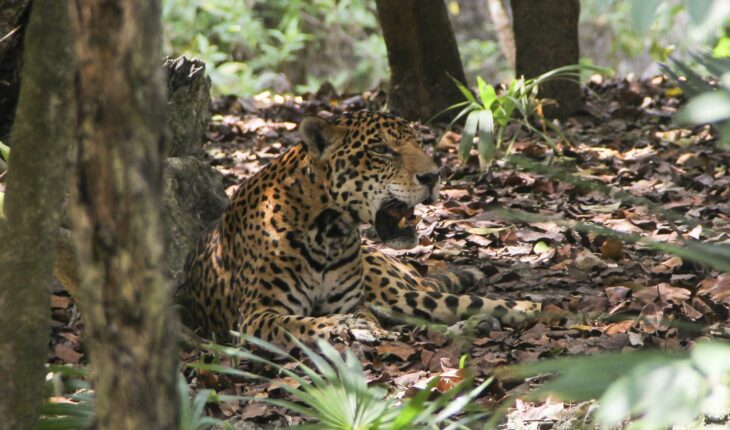Every year, up to seven jaguars lose their lives run over in the Calakmul Biosphere Reserve.
The deforestation driven by the works of various kinds in recent years in the area, to which the work of the Mayan Train will soon also be added, has affected the safety of this species in danger of extinction.
This is revealed by data and estimates from activists, experts in road ecology and representatives of the National Commission of Protected Natural Areas (CONANP), who warn that the balance of deceased felines is conservative due to the black figure of jaguars run over and that are not reported.
They also reiterated that there is a lack of specific official records.
The Yucatan Peninsula is home to at least 2,800 jaguars, according to the last census of 2018; however, the jaguar and other species were affected by their biological corridors by the deforestation that was made for the construction of federal highway 186 –which goes from Escárcega, Campeche, to Chetumal, Quintana Roo–, as well as the development of electrical infrastructure and agricultural production, explained the sources consulted.
In the Calakmul Biosphere Reserve alone, these projects have caused the clearing of a thousand hectares each year, according to data from the Federal Attorney for Environmental Protection (Profepa).
Photo: Alianza Jaguar.
This media sought an official position of Profepa and the central offices of CONANP on the run over of jaguars and those responsible, but so far there has been no response.
“I have been working in the Yucatan Peninsula since 2000, before there were reports of three jaguars run over a year, but now we have more reports, for example, on the Calakmul highway we have at least five reports a year, even up to seven,” said Heliot Zarza Villanueva, a member of the National Alliance for the Conservation of the Jaguar, and one of the authors of the National Census on the Jaguar (Cenjaguar).
Carlos Coutiño Cal y Mayor, deputy director of the Calakmul Biosphere Reserve of the National Commission of Protected Natural Areas, explained that they do not have a specific statistic of jaguars run over, but that this situation is very recurrent.
Political Animal conducted a review of reports of jaguar run over in the Calakmul area by Profepa, CONANP, activists, scientific studies, the Platform Registry of Fauna run over on Mexican roads and journalistic reports, but each source handles different data, between two and seven average incidents per year, from 2016 to date.
Photo: Alianza Jaguar.
The variation of these figures has an explanation: that not all jaguar runs over are reported or treated, although it is a crime with a penalty ranging from one to nine years in prison, according to article 420 of the Federal Criminal Code.
Experts consulted by this media agreed that the inhabitants are the ones who mainly report the corpses – usually abandoned in the ditches of the roads – but sometimes they do not do it or only stay in reports of social networks.
To this is added that the representatives of environmental authorities or the reserve are overwhelmed, having few personnel for the 723 thousand hectares of the Calakmul Biosphere Reserve.
“They don’t have the capacity, they don’t have the time, they don’t even have the resources for gasoline,” Mirna Manteca, a biologist and expert in road ecology, said in an interview.
“To make these records, the driver has to get off, put himself at risk and then warn that he ran over an animal and will not do it. On the other hand, citizens sometimes do not report it because there is a lack of knowledge.”
Heliot Zarza Villanueva, an expert in wild mammal conservation, explained that it is common for the inhabitants of the area to only make the report by WhatsApp, but finally who must confirm and make a file is the staff of Profepa, some park rangers, representatives of the reserve or officials of CONANP, but, in the end, everything will depend if there are personnel available to attend the report.
These outrages and the lack of information arise despite the fact that there are various projects for the conservation and monitoring of the jaguar in the Yucatan Peninsula, carried out by the local and federal government, as well as civil organizations and other countries.
Biologist Mirna Manteca explained that most of these crimes against the jaguar go unpunished.
“Sometimes there are no reports, there is no investigation, the same thing happens with the illegal hunting of jaguars. We know what happened, we know who did it, but there is impunity and nothing happens at any time. And we have the drivers who kill a jaguar on the road, but he’s not going to report it, maybe he doesn’t know that he isIt’s a crime, but even if he knew, he’s not going to do it. And this speaks of a lack of information on the part of the population and decision makers,” said the expert.
Photo: Alejandro Prieto, for Alianza Jaguar.
In the jaguar’s house… roads and Mayan Train
According to data from Fonatur, work is being done on the environmental impact and wildlife passages of section 7 of the Mayan Train, for that reason the route is not yet ready. What is known is that it will have an extension of 287 kilometers and will go from Bacalar, in the state of Quintana Roo, to Escárcega, in Campeche.
That is, it will cross 100 kilometers of the Calakmul Biosphere Reserve. The railway project contemplates a strip of 40 meters of space around the track; and it could even become a disturbed strip – including clearing – 100 meters wide, contemplating roads and electric transmission lines already existing.
The technical sheet of the Mayan Train indicates that this project could interrupt the natural biological corridors of species that transit from Central America to the Yucatan Peninsula. That is, the habitat of the jaguar.
Fonatur reported that the Mesoamerican jaguar corridor has been disturbed since the last century with the construction of Federal Highway 186, where incidents of running over have indeed been reported.
Heliot Zarza, of the National Alliance for the Conservation of the Jaguar, explained that on that road the system of phototraps has detected that jaguars and their prey arrive there without difficulty.
“The road is wide, it is not a physical or impassable barrier for jaguars. There are many phototrap studies; to the south and north of the road we see jaguar flow. Especially at night, we have detected that motorists pass, animals see the lights and remain motionless; and that’s when they get run over; we know that it is run over because they are in the ditch of the road, the animal is complete, they do not remove its skin or it is not hunting, “said Zarza.
Carlos Coutiño Cal y Mayor, deputy director of the Calakmul Biosphere Reserve, explained that jaguars and other species migrate mainly when there is drought in the jungle. When there are no longer available bodies of water, they migrate south to Guatemala; and it is on that route where some run overs occur.
Some of the experts consulted by Political Animal They warned that the jaguar could be at greater risk with the passage of the Mayan Train, especially if the wildlife passages are not carried out with research, because a wildlife passage for a jaguar is not the same as for a monkey, and many times the years it can last are not contemplated, because perhaps in decades the biological corridors change.
“In large projects like the Mayan Train or other roads, sometimes things like they need 100 steps of fauna are thrown into the air, and we are going to put them here or here, because that is how it suits us, or there are drains for water and we are going to take advantage of them. But the process of identifying the passage of fauna is very long. It takes a lot of data and a lot of research to know where you have to put it, what kind of fauna you are going to put. A wildlife passage for jaguars is not the same for monkeys or smaller species. There is a lot of variability in the infrastructure, in the design and many times the surrounding context is not contemplated either, if there are fences or there are train tracks, villages or agriculture, “said biologist Mirna Manteca.
The expert in road ecology added that the Ministry of Communications and Transport has manuals on how to make a model of wildlife passage; however, he criticized that it is almost not applied in any road project in Mexico.
“Unfortunately, road or infrastructure projects want to be done now; and designing wildlife passages takes a lot of time, because now we have to add climate change, where our landscapes are changing. So we are not sure that if I put a wildlife passage in a place, in 50 years it will no longer work. It is another component that has to be analyzed, but it is very complicated. Wildlife passages work if they are done well, if they are planned and done with time,” said Mirna Manteca.
The other threats
Carlos Coutiño Cal y Mayor, of CONANP, reported that there are more threats to the jaguar, such as illegal hunting. For example, north of the Calakmul Biosphere Reserve are cattle producers who have hunted jaguars because they are not satisfied with the subsidies or compensation granted to them after the feline attacked their livestock.
“Many times the jaguar attacks again and again, or makes a killing (of cattle). On one occasion there were 37 dead sheep, but only one was eaten. Then there are considerable losses, the producer does not see answers for the iHe then takes action by his own hands against the wildlife. Obviously in the communities they are not going to warn that they have already killed the jaguar, they just kill it and they don’t say anything,” Coutiño said.
Heliot Zarza Villanueva, a member of the National Alliance for the Conservation of the Jaguar, reported that there are also poachers, but they are on a smaller scale; however, the threat that is growing and preying on the jaguar’s habitat are traffickers of precious timber, who are armed.
“We have illegal cutters and there is a mafia behind them. They look for woods such as mahogany, cedar and other tropical woods that due to their color and shape are very coveted. They have already entered the Calakmul Biosphere Reserve, they are from organized crime and they leave with (wooden) trucks. We report to the National Guard, because we need people who can face these criminals, because they are armed, because they know that what they are doing is very illegal,” said Zarza Villanueva.
So far there is also no complete statistic of jaguars killed by these activities near the Calakmul Biosphere Reserve.
What we do at Animal Político requires professional journalists, teamwork, dialogue with readers and something very important: independence. You can help us keep going. Be part of the team.
Subscribe to Animal Político, receive benefits and support free journalism.#YoSoyAnimal





